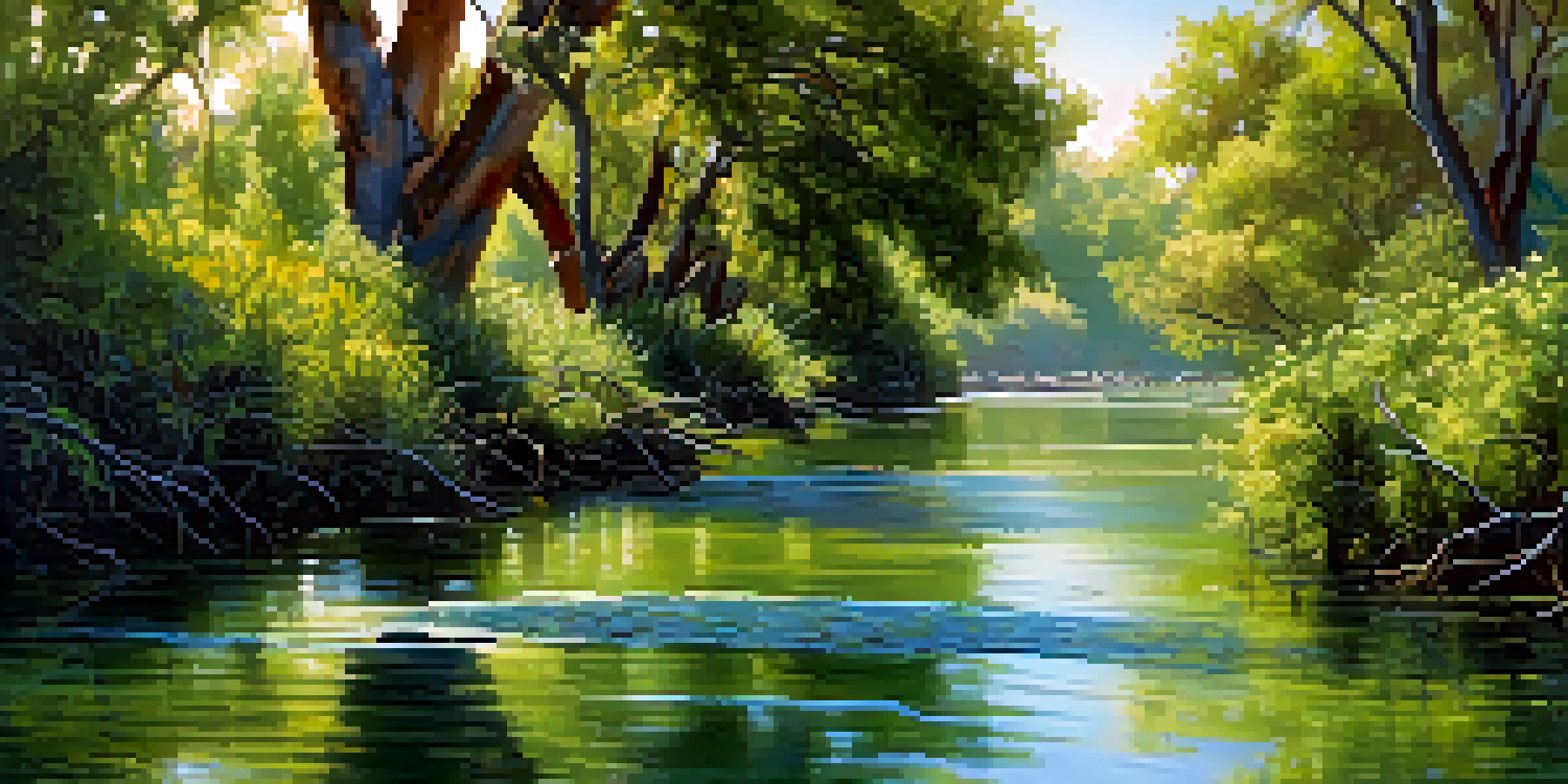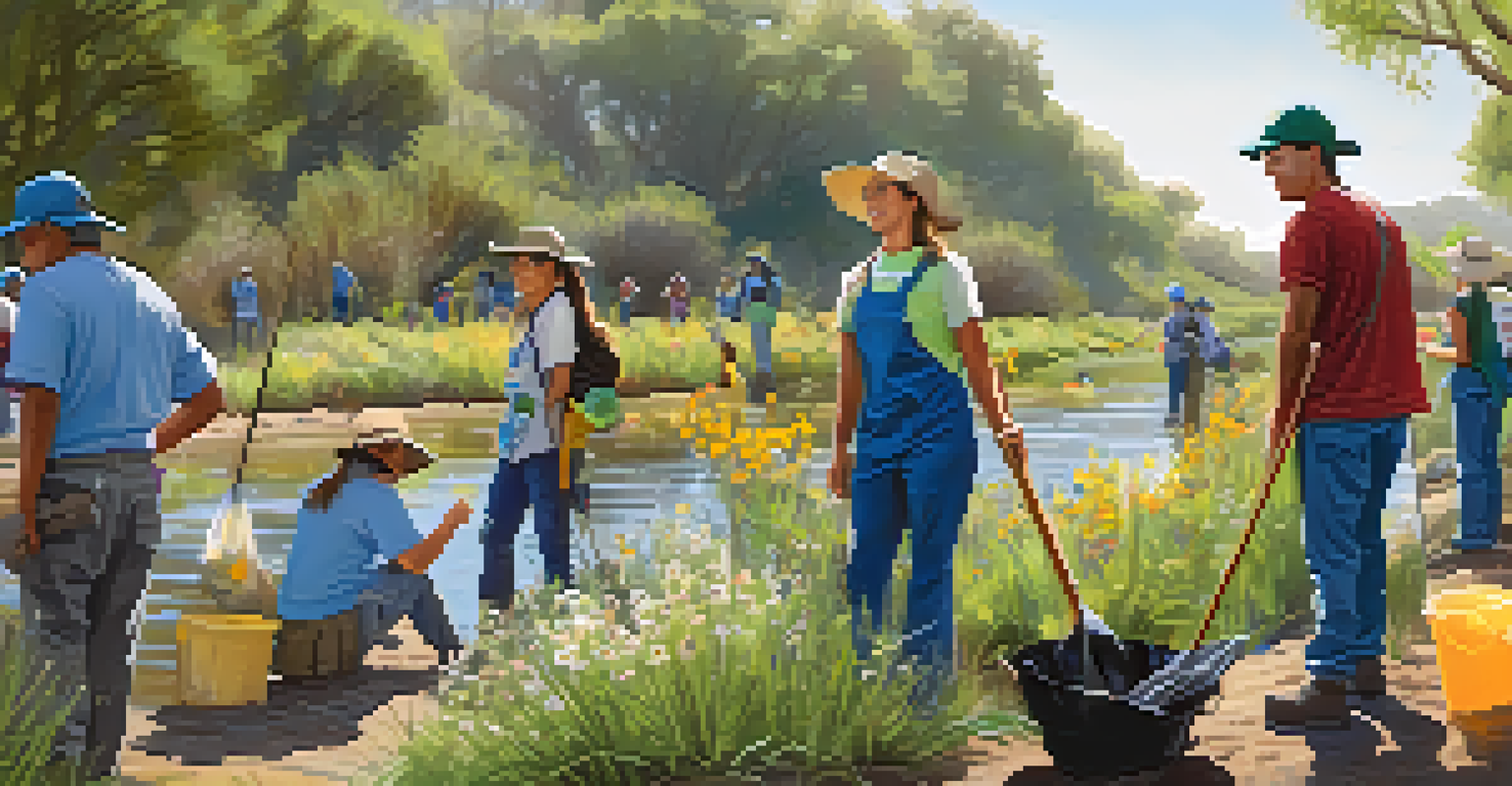The San Diego River: A Vital Habitat for Local Wildlife

Overview of the San Diego River Ecosystem
The San Diego River stretches about 52 miles from the mountains to the ocean, offering a diverse habitat for various species. This unique ecosystem includes riparian zones, wetlands, and upland areas that provide essential resources for wildlife. With its diverse habitats, the river supports an array of flora and fauna, making it a critical part of San Diego’s natural landscape.
In every walk with nature one receives far more than he seeks.
From its origins in the Cuyamaca Mountains to its mouth at the Pacific Ocean, the river flows through urban and rural areas, showcasing a blend of environments. This journey not only shapes the landscape but also creates niches for different species to thrive. The river is a vital artery, nourishing wildlife and plants while maintaining the ecological balance of the region.
Understanding the river's ecosystem is crucial for conservation efforts. By learning about the various habitats along the river, we can appreciate the interconnectedness of life and the importance of preserving these areas for future generations.
Wildlife Species Found Along the River
The San Diego River is home to numerous wildlife species, including fish, birds, mammals, and reptiles. Some of the notable residents include the endangered California least tern and the federally threatened Western snowy plover. These species rely on the river's habitats for nesting, feeding, and migration, highlighting the area's ecological significance.

Fish species such as the native steelhead trout can be found in the river's cooler waters, while various amphibians thrive in its wetlands. Birds flock to the riverbanks, drawn by the abundant food sources and nesting sites. This rich biodiversity not only adds beauty to the river but also plays a vital role in maintaining the local ecosystem.
Biodiversity Along the River
The San Diego River supports a rich variety of wildlife, including endangered species, which highlights its ecological importance.
Recognizing the importance of these species helps foster a sense of stewardship among the community. By protecting their habitats, we ensure the survival of these wildlife populations and contribute to the overall health of the environment.
The Role of Riparian Zones in Wildlife Habitat
Riparian zones, the interfaces between land and water, are crucial for the wildlife along the San Diego River. These areas provide shelter, food, and breeding grounds for various species. The lush vegetation found in riparian zones serves as a buffer, filtering pollutants and stabilizing soil, which benefits both wildlife and water quality.
The environment is where we all meet; where we all have a mutual interest; it is the one thing all of us share.
The dense plant life in riparian zones attracts insects, which in turn provide food for birds and other animals. This creates a vibrant ecosystem where every species plays a role in maintaining balance. By preserving these zones, we support the intricate web of life that depends on the river.
Unfortunately, urban development and pollution threaten these vital habitats. It’s essential to raise awareness about the importance of riparian zones and advocate for their protection to ensure that wildlife can continue to thrive in this ecosystem.
Impact of Urbanization on the San Diego River
Urbanization has significantly changed the landscape of the San Diego River, impacting wildlife habitats. As cities expand, natural areas are often replaced with concrete and infrastructure, disrupting the delicate balance of the ecosystem. This encroachment can lead to habitat fragmentation, making it more challenging for wildlife to thrive.
Pollution from runoff and increased human activity also pose significant threats to the river's health. Contaminants can harm aquatic life and degrade water quality, which in turn affects the entire ecosystem. The challenge lies in finding a balance between urban development and wildlife conservation.
Impact of Urbanization
Urban development poses significant threats to the river's ecosystem, leading to habitat fragmentation and pollution.
Community initiatives focused on restoration and conservation can help mitigate these impacts. By engaging local residents in clean-up efforts and habitat restoration projects, we can foster a sense of ownership and responsibility for the river's health.
Conservation Efforts for the San Diego River
Numerous organizations are dedicated to the conservation of the San Diego River and its surrounding habitats. These efforts range from habitat restoration projects to public education campaigns aimed at raising awareness about local wildlife. Collaborative initiatives often involve partnerships between government agencies, non-profits, and community members.
Restoration projects focus on rehabilitating degraded areas along the river, reintroducing native plants, and improving water quality. These actions not only enhance wildlife habitats but also provide recreational opportunities for the community. Engaging the public in conservation efforts fosters a greater appreciation for the river’s ecological significance.
Education plays a crucial role in these conservation efforts, as it empowers individuals to contribute positively to the environment. By understanding the importance of the San Diego River, residents are more likely to participate in preservation activities and advocate for sustainable practices.
The Importance of Community Involvement
Community involvement is vital for the successful conservation of the San Diego River. Local residents can make a difference by participating in clean-up events, habitat restoration projects, and educational programs. Engaging the community fosters a sense of pride and responsibility towards the river and its wildlife.
Moreover, community members can act as stewards of the environment by reporting pollution or illegal activities that harm local habitats. Their vigilance can help protect the river and its inhabitants, ensuring that future generations can enjoy its beauty and biodiversity. This collective effort creates a supportive network committed to preserving the river’s health.
Community Conservation Efforts
Active community involvement is crucial for the successful conservation of the San Diego River and its surrounding habitats.
By fostering a culture of conservation, communities can implement sustainable practices that benefit both wildlife and residents. Simple actions, like reducing water waste and planting native species, can have a lasting impact on the river’s ecosystem.
Future Outlook for the San Diego River
The future of the San Diego River relies on continued conservation efforts and community engagement. As urban pressures increase, it is essential to prioritize sustainable development practices that consider the river’s ecological health. This can be achieved through careful planning and community collaboration.
Innovative solutions, such as green infrastructure and wildlife corridors, can help mitigate the impacts of urbanization. By integrating natural systems into urban planning, we can create spaces that support both wildlife and human needs. This approach fosters a harmonious relationship between the river and the surrounding communities.

Ultimately, the preservation of the San Diego River is a shared responsibility that requires ongoing commitment. By working together, we can ensure that this vital habitat remains a thriving ecosystem for generations to come.